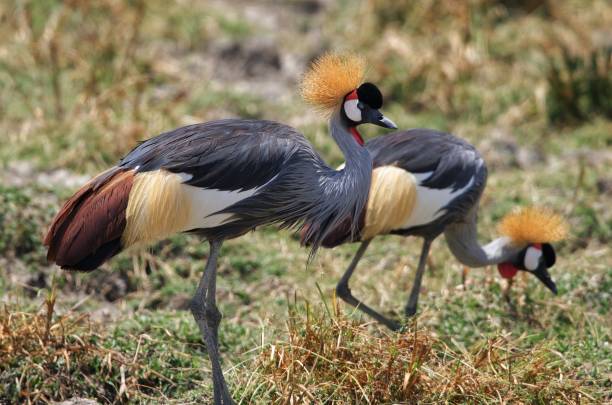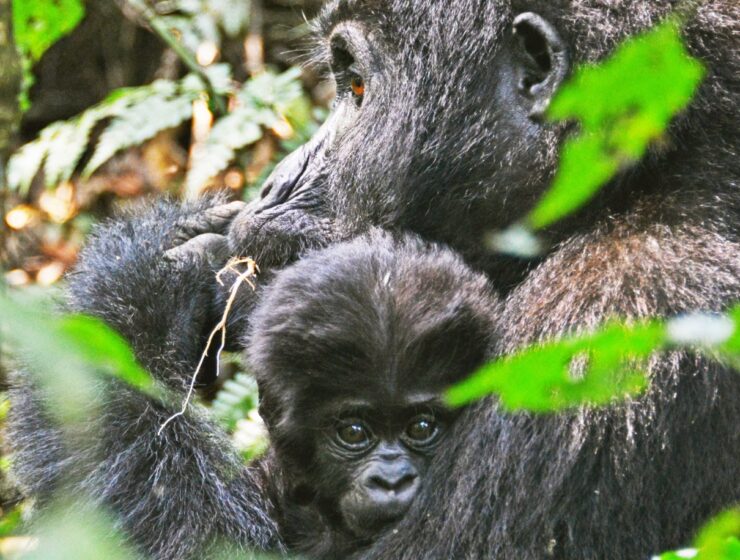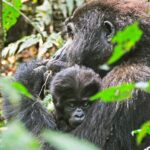BIRDING IN UGANDA
Uganda’s vibrant birdlife offers a captivating journey into the heart of Africa’s natural wonders. With over 1,000 species to discover across diverse habitats, from lush forests to expansive wetlands, Uganda promises an unforgettable birdwatching adventure. Here are 12 birds you shouldn’t miss when visiting Uganda:
Shoebill: This large, prehistoric-looking bird is a top highlight for birdwatchers visiting Uganda. It’s often found in wetlands and swamps, such as the Mabamba Swamp near Lake Victoria. The Shoebill is instantly recognizable by its unique appearance, characterized by its massive, shoe-shaped bill, which gives it its name. It stands at around 4 to 5 feet tall, making it one of the largest bird species in Africa. Its plumage is predominantly a slate-gray color, providing excellent camouflage in its swampy habitat.
Shoebills have large, broad wings and long legs, which are well-adapted for wading through shallow waters. Shoebills are typically solitary birds, often found alone or in pairs. They are highly territorial, especially around their nesting sites. They are incredibly patient hunters, standing motionless for long periods, waiting for prey such as lungfish, catfish, and even baby crocodiles to approach within striking distance. Despite their large size, they are surprisingly agile and can move stealthily through the dense vegetation of their wetland habitats. Shoebills are known for their distinctive bill-clattering behavior, which is thought to be a form of communication between individuals. Their breeding biology is still not fully understood due to the remoteness of their habitats and the difficulty in studying them.
Grey Crowned Crane: Uganda’s national bird, the Grey Crowned Crane, is a symbol of the country’s rich biodiversity. It is distinguished by its striking appearance, featuring a crown of golden feathers atop its head, which contrasts with its grey plumage. The long, slender neck, bright red throat pouch, and white wings further contribute to its regal appearance. These cranes inhabit various wetland habitats, including savannas, marshes, and grasslands.
They are known for their elaborate courtship displays, which involve dancing, bowing, and leaping. These displays not only serve to attract mates but also to reinforce pair bonds. Grey Crowned Cranes are omnivorous, feeding on a diet consisting mainly of plants, seeds, insects, and small vertebrates. They forage primarily on the ground, using their long bills to probe for food in the soil and vegetation. You can spot them in grasslands and wetlands across Uganda.
Saddle-Billed Stork: This iconic and visually striking bird is one of the tallest storks in the world, with adults reaching heights of up to 150 cm (5 ft) and wingspans of around 270 cm (9 ft). It gets its name from the prominent saddle-shaped bill, which is black with a yellow or red frontal shield. Their plumage is predominantly black and white, with glossy black wings and a contrasting white body. The legs are long and pinkish-red in color. Saddle-Billed Storks inhabit a variety of wetland habitats, including marshes, swamps, and the edges of lakes and rivers.
They are primarily found in sub-Saharan Africa, ranging from Senegal in the west to Ethiopia and South Africa in the east and south. These storks are carnivorous and feed mainly on fish, frogs, crustaceans, and other small aquatic animals. They are solitary feeders and often hunt by wading slowly through shallow water, using their sharp bills to catch prey with lightning-fast strikes.
African Grey Parrot: Known for its intelligence and mimicry skills, grey parrots in the wild exhibit secretive personalities, making them challenging to study. They imitate a wide variety of sounds they hear, similar to their captive counterparts, showcasing their intelligence and adaptability. Wild grey parrots have been recorded with a diverse repertoire of calls, including imitations of other bird songs and even a bat.
Grey parrots are primarily frugivorous (fruit eaters), with fruits, nuts, and seeds making up most of their diet. They also consume oil palm fruit, flowers, tree bark, insects, and snails. In the wild, they are known to forage partly on the ground, demonstrating their adaptability in finding food sources. Grey parrots are monogamous breeders that nest in tree cavities, with each mated pair requiring its own nest tree. The female lays three to five eggs, which she incubates for about 30 days while being fed by her mate. Both parents defend their nesting sites and care for the chicks. Chicks require feeding and care from their parents in the nest and remain with them for about 4–5 weeks after fledging. Young grey parrots leave the nest at around 12 weeks of age, and their weight increases significantly from hatching to fledging.
African Fish Eagle: Recognizable by its distinctive call and impressive hunting skills, the African Fish Eagle is a common sight around Uganda’s lakes and rivers. This eagle is instantly recognizable by its striking appearance, featuring a white head and chest, a brown body, and a hooked yellow beak. Its most distinguishing feature, however, is its piercing yellow eyes, which add to its commanding presence. As its name suggests, the African Fish Eagle is primarily a fish hunter, swooping down from its perch or soaring above the water to snatch fish near the surface. However, it’s also known to opportunistically feed on other aquatic creatures, as well as birds, reptiles, and even carrion.
African Fish Eagles are skilled hunters and formidable predators, with sharp talons and keen eyesight. They often build large nests in tall trees near water bodies, using sticks, grass, and other materials. These nests can become substantial structures over time, sometimes reaching several meters in diameter. Mated pairs of African Fish Eagles are known for their strong bonds, often staying together for life. They engage in elaborate aerial displays during the breeding season, soaring high into the sky and locking talons before descending in a graceful spiral.
African Green Broadbill: This small, elusive bird is found in the dense forests of equatorial Africa, particularly in countries such as Cameroon, Gabon, Congo, and Uganda. It is renowned for its stunning green plumage and unique appearance. Breeding behavior and nesting habits of the African Green Broadbill are not well-documented due to its elusive nature. However, it’s believed to construct cup-shaped nests made of plant materials, typically situated in the dense undergrowth of forests.
Papyrus Gonolek: Found in the papyrus swamps of Uganda, the Papyrus Gonolek is known for its striking black, red, and white plumage. It’s a unique bird that’s endemic to the region. This bird is easily recognized by its bold black, red, and yellow coloration. Its black head and back are contrasted by bright red underparts and a striking yellow eye-ring. Its tail is long and graduated, adding to its overall elegance. Papyrus Gonoleks are typically found in dense stands of papyrus reeds, where they forage for insects and other invertebrates among the vegetation. They are adept at climbing and hopping through the tangled growth of the wetlands in search of prey. One of the most notable features of the Papyrus Gonolek is its melodious and varied vocalizations. Its calls consist of a mixture of whistles, trills, and chatters, which serve for communication within their territories and among mating pairs.
Black Bee-eater: Predominantly black in coloration, this bird has glossy plumage that may exhibit shades of green and blue in certain lighting conditions. It has a slender, elongated body, a long, decurved bill specialized for catching insects, and distinctive elongated central tail feathers. This bird is typically found in savannas, grasslands, woodland edges, and scrub habitats, where it perches on exposed branches or wires, scanning for flying insects such as bees, wasps, and dragonflies. Once it spots its prey, the Black Bee-eater swoops down with remarkable agility, catching insects mid-air with its sharp bill before returning to its perch to consume its meal.
Breeding behavior in Black Bee-eaters typically occurs during the rainy season when insect populations are abundant. They excavate burrows in sandy or loamy soil, often near riverbanks or cliffs, where the female lays a clutch of eggs. Both parents share the responsibilities of incubating the eggs and feeding the chicks.
Great Blue Turaco: This striking bird is native to central and western Africa. Its most distinctive feature is its vibrant blue plumage, which contrasts beautifully with its bright yellow face and beak. This bird belongs to the Musophagidae family, commonly known as turacos or plantain eaters, due to their preference for fruits, especially those of the plantain tree. In addition to its colorful appearance, the Great Blue Turaco is known for its loud, distinctive calls, often described as sounding like a deep, rolling “gow.” These calls are used for communication within their social groups and for establishing territory.
Great Blue Turacos typically inhabit dense forests and woodlands, where they forage for fruits, seeds, and sometimes insects. They are known to be highly arboreal, spending much of their time in the canopy of trees. These birds are monogamous and form long-term pair bonds. They build large, untidy nests in the trees, where the female typically lays two eggs. Both parents share the responsibility of incubating the eggs and caring for the chicks.
Eastern Grey Plantain-eater: As its name suggests, the Eastern Grey Plantain-eater is predominantly gray in color, with subtle variations in shades across its plumage. It has a crest of feathers on its head, which it can raise or lower depending on its mood or to communicate with others. Additionally, it features a bright red facial patch around its eye, adding a splash of color to its otherwise subdued appearance. These birds are typically found in wooded habitats such as forests, woodlands, and savannas, where they forage for a variety of foods, including fruits, seeds, flowers, and insects.
They are known for their loud, distinctive calls, often heard echoing through the trees as they communicate with one another or establish territory. Eastern Grey Plantain-eaters are generally social birds, often seen in pairs or small groups. They are monogamous and form long-term pair bonds, sharing responsibilities such as nest building, incubating eggs, and caring for their young. With its distinctive call and colorful appearance, the Eastern Grey Plantain-eater is a common sight in Uganda’s woodlands and savannas.
Secretary Bird: This iconic bird of prey is found in the open grasslands and savannas of sub-Saharan Africa. It is instantly recognizable by its distinctive appearance, characterized by its long legs, upright posture, and crest of feathers on its head. Secretary Birds are large, standing up to 1.3 meters (over 4 feet) tall, with a wingspan of around 2 meters (over 6.5 feet). They have long, slender legs adapted for walking and running, rather than perching like most other birds of prey.
Their plumage is mostly gray with black flight feathers and tail, while their faces are covered in bare, orange skin. These birds are formidable predators, primarily hunting on foot. They use their powerful legs to stomp on prey, which can include insects, rodents, snakes, lizards, and even small mammals like hares. Their long legs also provide them with a vantage point to see over the tall grasses of their habitat, aiding in spotting prey from a distance. Secretary Birds are monogamous and often mate for life. They construct large nests made of sticks and grass in trees or on rocky outcrops. Both parents share the responsibilities of incubating the eggs and caring for the chicks.
African Pygmy Kingfisher: This tiny but vibrant bird is found across sub-Saharan Africa. Despite its small size, about 12 cm (4.7 in) in length, it boasts striking plumage with bright blue and orange colors. These colors are often more vivid in males than females. This kingfisher inhabits various habitats, including forests, savannas, and grasslands, typically preferring areas near water bodies such as streams, rivers, or ponds. Its diet mainly consists of insects, small fish, and aquatic invertebrates, which it hunts by perching low to the ground or hovering briefly before diving to catch its prey.
Breeding usually occurs during the rainy season when insects are abundant. The African Pygmy Kingfisher constructs its nest in riverbanks or termite mounds, excavating a tunnel leading to a chamber where the eggs are laid. Both parents participate in incubating the eggs and feeding the chicks.
These are just a few of the many incredible bird species you can encounter in Uganda. Whether you’re exploring the forests, wetlands, or savannas, keep your binoculars ready for a birding experience like no other.
Conclusion: Embarking on a birdwatching expedition in Uganda, you not only immerse yourself in the awe-inspiring sights and sounds of nature but also contribute to conservation efforts that safeguard these precious feathered treasures. Come spread your wings and join us in Uganda, where every flap echoes a symphony of life. Avents Safaris is inviting you to witness the magic of birds in their natural habitat. Let’s soar together towards a future where birds continue to enchant and inspire generations to come. Uganda awaits, ready to unveil its avian wonders and ignite your passion for adventure.






